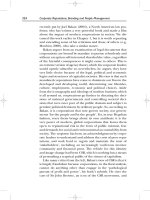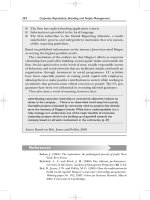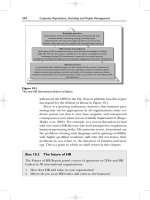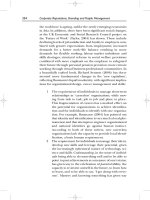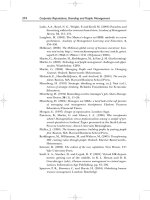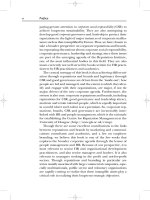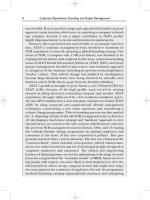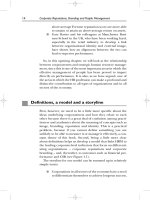Tài liệu Corporate Reputations, Branding and People Management 3 ppt
Bạn đang xem bản rút gọn của tài liệu. Xem và tải ngay bản đầy đủ của tài liệu tại đây (101.36 KB, 10 trang )
4 Corporate Reputations, Branding and People Management
was two-fold. First, its product range and expertise fell outside top man-
agement’s main interests, which were in acquiring a computer technol-
ogy company. Second, it was a major contributor to NCR’s profits,
highly disproportionate to its size and investment requirements.
However, after a period of two years of little or no strategic interven-
tion, AT&T’s corporate management team decided to transform its
NCR acquisition en masse by adopting a global branding strategy. The
name of NCR, a company with a 100 year history, was destined to be
expunged from history and replaced by the more corporate-sounding
name of AT&T Global Information Solutions (AT&T (GIS)) and head-
quarter management decided to take a more interventionist approach
to all aspects of the business, including its previous technology-based,
‘macho’ culture. This radical change was justified by headquarters
because large financial losses were being incurred by virtually every
business unit in NCR, that is, apart from the Scottish subsidiary.
AT&T’s president brought in Jerre Stead, a new US-based CEO for
AT&T (GIS), because of his high profile track record in turning
around an ailing electrical contracting company and another AT&T
acquisition. Strongly influenced by a US academic-consultant ‘guru’,
the new CEO embarked on a near-messianic attempt to re-brand AT&T
(GIS) by using corporate and organizational identity management
techniques, constructing a new vision statement and introducing a
culture change programme. This re-branding process was also marked
by: (1) disposing of many of the old NCR management team in America;
(2) developing a much more strategic and ‘hands-on’ approach to strat-
egy and tactics, in contrast to the sole concern with financial control by
the previous NCR management team in Dayton, Ohio; and (3) basing
the cultural/identity change programme on putting employees and
customers at the heart of the new corporation’s policies. This pro-
gramme involved three central elements. The first was christened the
‘Common Bond’, which included a best-practice, ethical mission state-
ment, new values framework and set of working principles designed to
‘empower employees and customers’. The ethical and empowering
features of this programme are worth emphasizing at this stage, because
it has been argued that the ‘mutuality model’ of HRM, based on treat-
ing people with respect, was more likely to lead employees to view the
effort positively and to accept company actions that might have nega-
tive consequences for a minority of employees. Second, the programme
involved flattening existing organizational structures and attempting
This second case not only illustrates the desire by firms such as
AT&T for a strong sense of ‘corporateness’ as a means of com-
petitive advantage, but also details how reputations and brands
are made or broken by the values, attitudes and behaviour of
people, most notably leaders and board members, who shape
the cultures and identities of their firms. Perhaps just as import-
ant from our perspective, it also implies great potential for more
effective human resource management (HRM) to contribute to
Chapter 1 The importance of the corporate agenda and its links with HRM 5
to empower the local managers and workforce by, among other tech-
niques, re-labelling managers and supervisors as ‘coaches’ and workers
as ‘associates’. Third, Stead took a personal lead in the programme by
attempting to drive the changes through in a matter of nine months,
including many personal appearances in the UK and an enormous
investment in corporate communications.
We tracked the effects of the programme on employee attitudes, val-
ues and acceptance of the new identity over a four-year period to allow
changes to bed down. However, Stead left the company after only 18
months following the sale of NCR by AT&T, which more or less signified
a failed acquisition and the end of the programme. It should come as lit-
tle surprise to readers that the attempted identity and culture change
failed miserably during the 18-month period of Stead’s stewardship.
The explanations we unearthed were quite complicated but centred on:
■ The programme being seen by local management and employees
in the Scottish subsidiary as an American-originated and orientated
programme, and a one-size-fits-all solution. It was viewed as the per-
sonal mission of two US nationals based at headquarters (Stead and
his academic guru). Stead was also seen to lack a track record in
managing international companies, which showed in the extremely
US-biased, evangelical language and content of the programme.
■ This sense of US parentage was markedly enhanced by an absence
of prior consultation and discussion with local management in the
Scottish subsidiary, apart from some HRM staff who stood to gain
from the process. Quite simply, the views of the prominent and
well-respected local CEO and many of his staff had not been sought
on the appropriateness of re-branding a company that was an
acknowledged world leader in its field.
Source: Based on Martin, Beaumont and Pate, 2003
the corporate agenda by designing and executing HR strategies
that support and drive corporate strategy rather than those that
hinder or follow it.
This book, then, addresses these issues from an HRM per-
spective, uniquely as far as we are aware, because a strong case
can be made that brands and reputations are driven from the
inside – sometimes well but often poorly. Because of this ‘inside-
out’ thesis, it follows that HR specialists have a great deal to con-
tribute if they can grasp the corporate agenda, organizational
needs for corporateness and begin to understand and use the
language and insights of branding, marketing, communications,
public relations and corporate social responsibility (CSR) spe-
cialists. Such a grasp has become progressively more important
because of the so-called ‘war for talent’, which will become even
more intense given the changing demographics of the major
world economies of Europe, Asia and even the USA (Pfeffer,
2005), the changing basis of competition towards the knowledge-
based and creative industries (Florida, 2005) and the calls for
more socially responsible, sustainable and well-governed organi-
zations (Clarke, 2004; Jackson, 2004).
For example, IBM is warning firms of the persistent talent
shortages brought about by the baby-boom generation reaching
retirement age, with their head of human capital management
cautioning that the ageing population will be one of the major
issues facing organizations in the 21st century. Most European
and Asian governments are facing quite rapidly ageing popula-
tions, but even the USA, which benefits from high levels of tal-
ented immigration, is estimated to be short of 17 million people
of working age by 2020. Another example comes from a recent
set of consulting surveys on the importance of corporate reputa-
tions and corporate branding not only to senior executives in
America and Europe but also to Asian executives, including
Chinese CEOs (Hill and Knowlton, 2004). One of these surveys
conducted in 2004, in conjunction with The Economist’s panel of
more than nine hundred senior executives worldwide, showed
that 93% of these respondents believed customers considered
corporate reputation to be either important or extremely import-
ant while 31% of them also believed that corporate reputation
was one of the top three factors that customers consider in
deciding to purchase from a company. Seventy-nine per cent of
6 Corporate Reputations, Branding and People Management
these senior executives also believed corporate reputations were
one of the top three factors that influenced investors in invest-
ment decisions. Recruiting and retaining talent was seen as the
most important benefit of building and maintaining a strong
corporate reputation, with 43 per cent seeing it as one of the top
three factors in attracting people to join (second only to com-
pensation and career growth). The survey of 120 senior leaders
of major Chinese companies showed that corporate reputation
and brand building were the most important objectives for their
organizations. Three-quarters of respondents said that brand
building was the most important business outcome of their
companies’ reputations. Nearly all of these executives saw these
brands as very important for developing strategic partnerships
and for recruiting and retaining talented people.
Before going any further, however, we need to define our
terms a little more accurately and consider the reasons why
corporateness has become part of the strategic agenda for
organizations (and, increasingly, cities, regions and nations).
The box below gives a working definition.
Chapter 1 The importance of the corporate agenda and its links with HRM 7
Key definition: Corporateness
We use the term ‘corporateness’ as an umbrella term for the various
powerful and revealing corporate-level concepts, including reputation,
identity, image, brand, vision, strategy, communications, culture, social
responsibility and governance that have come to form a new way of
thinking about organizations. Corporateness implies the desire for
many, especially large and complex, organizations to develop a unified
approach to business and present a distinctive corporate identity in key
areas such as branding, reputation, cost control and, increasingly, legit-
imacy to all stakeholders. This does not imply that such organizations
are uninterested in encouraging diversity or acknowledging, and often
promoting, the existence of legitimate sub-cultures, multiple identities
and employee segments, but that they need to balance the classic trade-
off, as economists put it, between the requirements for people to cooper-
ate to fulfil common goals and to show individual initiative in achieving
sub-unit goals (Roberts, 2004). Sometimes, organizational scholars refer
to this trade-off as the integration-differentiation problem.
Corporate reputations, brands and
business success
There are strong positive reasons for believing that reputations
and brands drive business success. Indeed, John Kay (2004), a dis-
tinguished British economist, has gone on record stating that
brands and reputations are among the very few sustainable stra-
tegic assets of an organization. Economists also argue that reputa-
tion is the most important means through which a market
economy deals with imperfect information. Perfect information
is so vital to efficient markets that consumers simply cannot have
too much information on which to base rational purchasing deci-
sions. And, of course, reputations work best when they are conta-
gious, when people with good reputations trade with others with
good reputations. For example, reputable firms will usually only
seek to partner with reputable celebrities to endorse their prod-
ucts, and vice versa. Marketing people point out that reputations
and brands only create value when they allow an organization to
enjoy relative advantages over others. It is this differentiation feature
of corporate reputations and brands that helps contrast them
with the topical interest in corporate social responsibility
(CSR) and governance that typically focus on conformance to
socially-accepted standards of behaviour and organizational legiti-
macy. David Deephouse and Suzanne Carter (2005) have sug-
gested that the distinction between the reputation and legitimacy
aspects of corporateness is based on the penalties incurred for
being different: reputations and brands gain significant credit for
being unique, whilst firms that do not match widely accepted stand-
ards for socially responsible behaviour – the CSR and govern-
ance agendas – incur penalties for non-conformance.
Let’s begin, however, by looking at the legitimacy problems
of organizations since, as we write, CSR and requirements to
improve corporate governance are two of the reasons driving
much of the current interest in corporateness. Recent corpor-
ate scandals in almost every country in the world have demon-
strated the risk associated with irresponsible behaviour and
poor governance to damaged reputations, brands and, in some
cases, the demise of companies. These include:
■ The decline in general levels of trust and consumer confidence
following the highly publicized cases of questionable
8 Corporate Reputations, Branding and People Management
